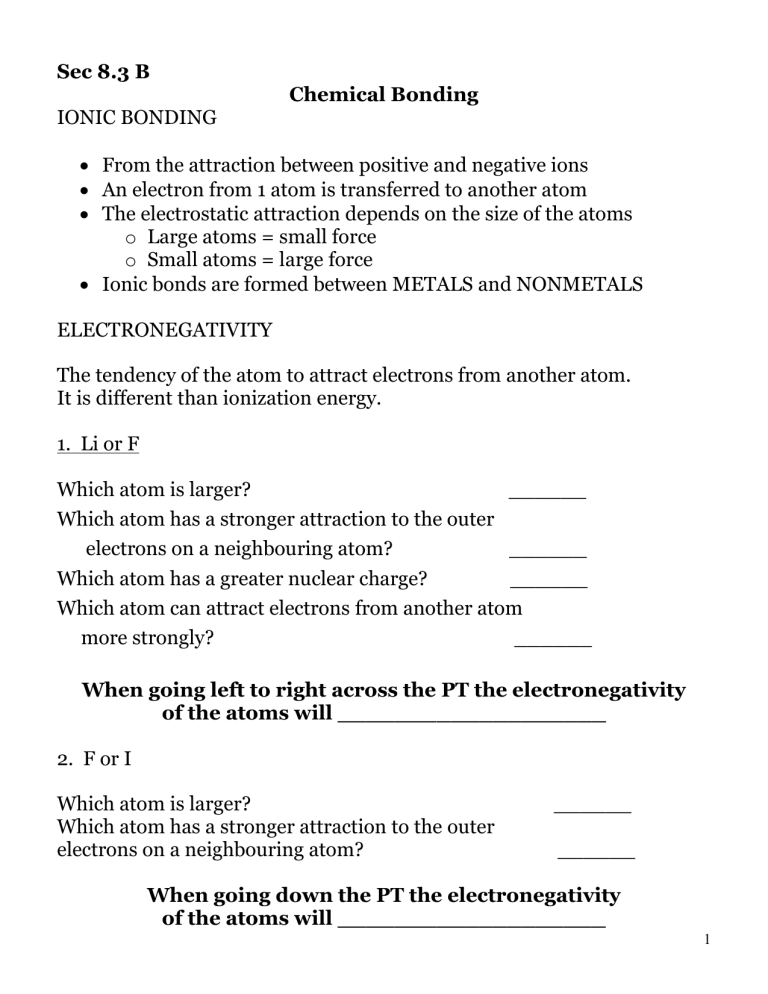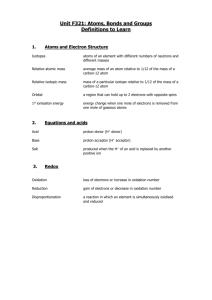Chemical Bonding

Sec 8.3 B
Chemical Bonding
IONIC BONDING
From the attraction between positive and negative ions
An electron from 1 atom is transferred to another atom
The electrostatic attraction depends on the size of the atoms o Large atoms = small force o Small atoms = large force
Ionic bonds are formed between METALS and NONMETALS
ELECTRONEGATIVITY
The tendency of the atom to attract electrons from another atom.
It is different than ionization energy.
1. Li or F
Which atom is larger? ______
Which atom has a stronger attraction to the outer
electrons on a neighbouring atom? ______
Which atom has a greater nuclear charge? ______
Which atom can attract electrons from another atom
more strongly? ______
When going left to right across the PT the electronegativity of the atoms will ___________________
2. F or I
Which atom is larger? ______
Which atom has a stronger attraction to the outer electrons on a neighbouring atom? ______
When going down the PT the electronegativity of the atoms will ___________________
1
Add arrows on the PT to show the increase in electronegativity
Trends in Electronegativity
The electronegativity increases (left to right) across the table because the atomic radius decreases and the attraction from the nucleus increases therefore the atom has lots of charge available to attract other electrons.
The electronegativity decreases down the table because the atomic radius increases and the attraction towards the electrons decreases, so the atom does not have extra charge to attract other electrons.
ELECTRONEGATIVITY has the SAME TREND as IONIZATION
ENERGY
Summary
If an atom is HIGHLY electronegative then it:
Is small
Has lots of protons and electrons close to the nucleus
Attracts its own electrons
Attracts other atoms electrons
If an atom has low electronegativity then it
Is larger
The electrons in different levels
The electrons are not held tight to the nucleus
2
MELTING POINTS
Does not attract other atoms electrons
The stronger the bond the higher the melting point because it takes more heat to break it.
Ionic bonds are very strong so the compounds have high melting points
Class work pg 172 # 57
Pg 174 # 62-64, 65, 66
3
Sec 8.3
Chemical Bonding
IONIC BONDING
From the attraction between ____________ and ____________ ions
An electron from 1 atom is ____________ to another atom
The electrostatic attraction depends on the size of the atoms o ____________ = ____________ o ____________= ____________
Ionic bonds are formed between METALS and NONMETALS
ELECTRONEGATIVITY
______________________________________________________________
It is different than ionization energy.
1. Li or F
Which atom is larger? ______
Which atom has a stronger attraction to the outer
electrons on a neighbouring atom? ______
Which atom has a greater nuclear charge? ______
Which atom can attract atoms from another atom
more strongly? ______
When going left to right across the PT the electronegativity of the atoms will ___________________
2. F or I
Which atom is larger? ______
Which atom has a stronger attraction to the outer
electrons on a neighbouring atom? ______
When going down the PT the electronegativity of the atoms will ___________________
Add arrows on the PT to show the increase in electronegativity
4
Trends in Electronegativity
___________________________________________________________________
___________________________________________________________________
___________________________________________________________________
_______________________________________________
___________________________________________________________________
___________________________________________________________________
____________________________________________________
ELECTRONEGATIVITY has the _____________as IONIZATION ENERGY
Summary
If an atom is HIGHLY electronegative then it:
____________
________________________________________________
____________________________________
____________________________________
If an atom has low electronegativity then it
MELTING PIONTS
____________
____________________________________
____________________________________
____________________________________
The stronger the bond the higher the melting point because it takes more heat to break it.
Ionic bonds are very strong so the compounds have high melting points
Class work pg 172 # 57
pg 174 # 62-64, 65, 66
5
Sec 8.3 B cont.
Covalent Bonding
Pg 176
Covalent bonds are:
A bond which involves equal sharing of electrons
2 atoms that have less than full shells of electrons are able to share 1 or more of their electrons to get full shells.
Involves NON-METALS only
Octet Rule
All of the atoms want to have 8 electrons in the outer most shell, except hydrogen can only have 2 electrons in the outer shell. (because the shell is to small for any more)
Why only NON-METALS?
Non-metals have very large electronegativities and ionization energies; therefore they can hold on to their own electrons tightly and can strongly attract electrons from other atoms.
Basically 2 non-metals will play tug-o-war with electrons and eventually share them. Not like metals that will lose their electrons quickly. (remember ionic bond → electron transfer)
Characteristics of Covalent Bonds
Very strong
Can share more than 1 pair of electrons
The more electrons that are shared = the stronger the bond = a short bond length
Bond Length
Depends on the size of the atom
The larger the atoms the longer the bond length = the weaker the bond.
Ex; NaCl will have a stronger bond than RbI
NaCl has a shorter bond length
Exceptions
NaF vs. MgO
These compounds have basically the same bond length, but MgO has a lot more electrons and excess charge. Therefore there is more electrostatic force and forms a stronger bond.
6
Other types of bonds…actually forces?
Molecules that have covalent bonds have other forces that hold them together. Inside the molecule itself there are INTRA MOLECULAR FORCES and outside the molecule there are
INTER MOLECULAR forces.
The outside forces are also called van der Waals forces. There are 2 types of van der
Waals forces:
Dipole – dipole force
Caused by excess charge on the atoms from large elctronegativities
Inside the atom
London Force
Caused by the excess charge attracting the neighbouring atom.
Outside and between 2 atoms
these are the weakest type of bonds – the more electrons that are present - the stronger the
London force.
I
I
I
I
I
Which forces are important?
1.
Ionic bonds and Covalent bonds
I
2.
Dipole forces
3.
London forces – only important if there are no other forces present because LF’s are always present.
Homework questions pg. 177 # 68 – 84
7
Sec 8.3 B cont.
Covalent Bonding
Pg 176
Covalent bonds are:
A bond which involves ______________________________________
2 atoms that have less than full shells of electrons are able to share 1 or more of their electrons to get full shells.
Involves ______________only
Octet Rule
All of the atoms want to have __________________________________________, except ______________ can only have ______________in the outer shell. (because the shell is to small for any more)
Why only NON-METALS?
Non-metals have ____________________________ and ______________ energies; therefore they can hold on to their own electrons tightly and can strongly attract electrons from other atoms.
Basically, 2 non-metals will play tug-o-war with electrons and eventually share them. Not like metals that will lose their electrons quickly. (remember ionic bond → electron transfer)
Characteristics of Covalent Bonds
Very strong
Can share more than 1 pair of electrons
The more electrons that are shared = the stronger the bond = a short bond length
Bond Length
Depends on the _____________________
The larger the atoms the longer the bond length = the weaker the bond.
Ex; NaCl will have a stronger bond than RbI
NaCl has a shorter bond length
Exceptions
NaF vs. MgO
These compounds have basically the same bond length, but MgO has a lot more electrons and excess charge. Therefore there is more electrostatic force and forms a stronger bond.
8
Other types of bonds…actually forces?
Molecules that have covalent bonds have other forces that hold them together. _______ the molecule itself there are _______MOLECULAR FORCES and _______ the molecule there are
_______ MOLECULAR forces.
The outside forces are also called _____________________forces. There are 2 types of van der Waals forces:
Dipole – dipole force
Caused by ______________on the atoms from large elctronegativities
Inside the atom
London Force
Caused by the excess charge attracting the neighbouring atom.
_______ or _______ 2 atoms
these are the weakest type of bonds – the ______________that are present - the
_______r the London force.
I
I
I
I
I
Which forces are important?
1.
Ionic bonds and Covalent bonds
2.
Dipole forces
I
3.
London forces – only important if there are no other forces present because LF’s are always present.
Homework questions pg. 177 # 68 - 84
9






